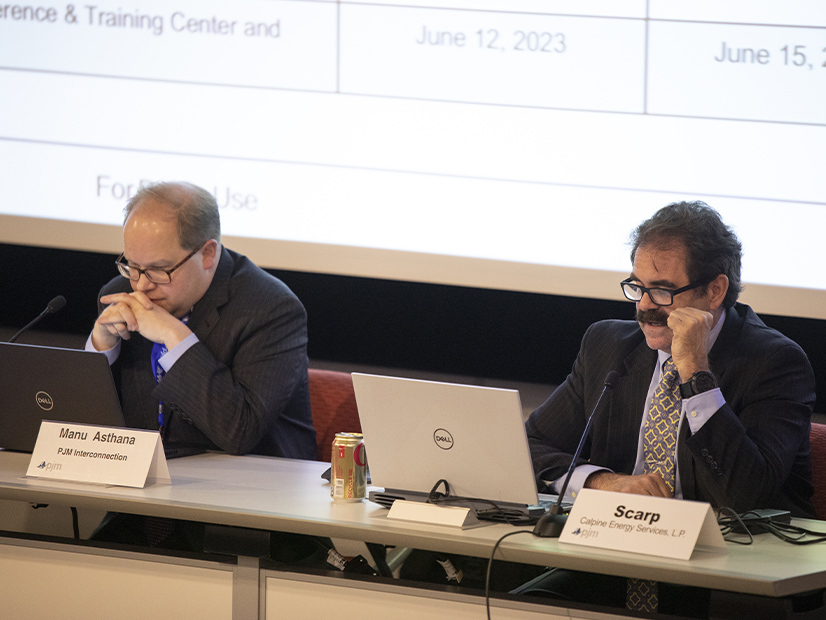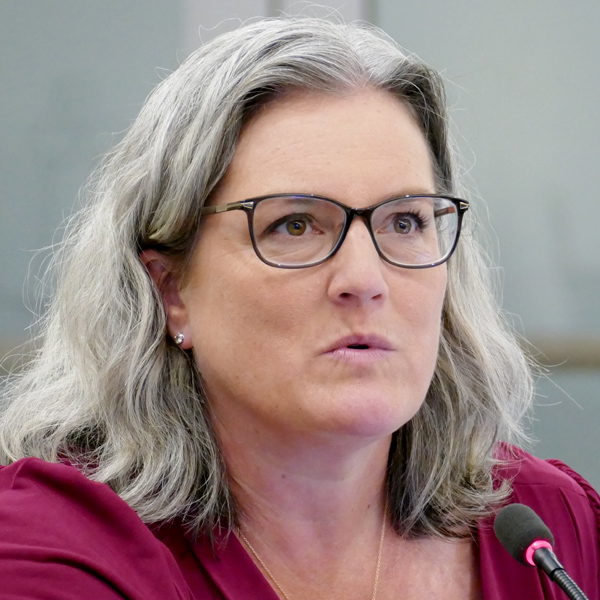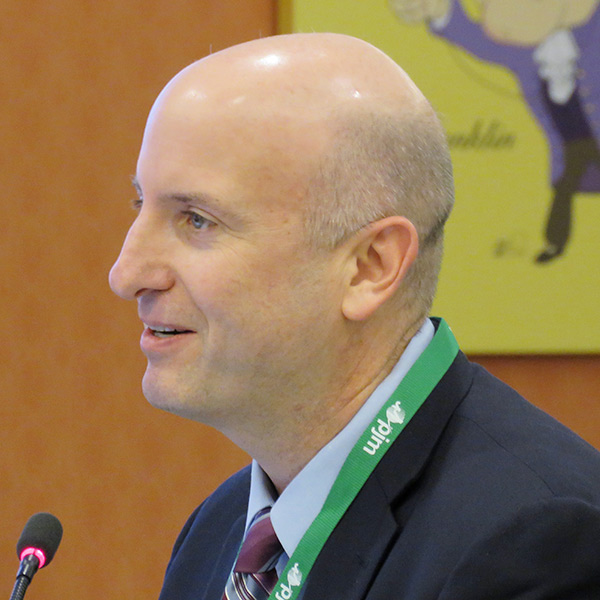
Markets and Reliability Committee
Two Proposals on ‘Circuit Breaker’ Fail
The PJM Markets and Reliability Committee rejected two proposals that would have created a “circuit breaker” mechanism to limit prices during extended periods of high prices.
Old Dominion Electric Cooperative, Southern Maryland Electric Cooperative and Northern Virginia Electric Cooperative had jointly proposed triggering a breaker when LMPs of at least $1,000/MWh last over the course of a 24-hour period, or $850 over a week. Prices would then be capped at $850/MWh until they remain below the cap for five consecutive business days.
The proposal would have also granted PJM the discretion to invoke the breaker based on conditions it’s observing; it would not have had the power to prevent a breaker being triggered. (See “Support for Circuit Breaker Remains Mixed,” PJM MRC Briefs: Oct. 24, 2022.)
 Adrien Ford, ODEC | © RTO Insider LLC
Adrien Ford, ODEC | © RTO Insider LLCAdrien Ford of ODEC said the circuit breaker is intended to be used only under extraordinary circumstances when the markets have gone “haywire.” For a small load-serving entity serving 200 MW of load, she said the total annual spending under typical average prices for the PJM footprint could be eclipsed in 2.25 days should prices reach the current $5,700/MWh cap, which includes maximum cost-based offers, reserve shortages and a $2,000/MWh transmission constraint penalty factor.
“The numbers just get cartoonish very quickly, and that’s why we’re trying to put this in place,” she said.
Calpine proposed a breaker triggered by 90 nonconsecutive hours of shortage events in one delivery year and cap prices at $2,000/MWh — a threshold the company’s David “Scarp” Scarpignato said is critical to proper price formation. After one breaker had been observed in a single year, any subsequent shortage in excess of three consecutive hours would trigger an additional breaker. The proposal would not provide PJM with the power to initiate a circuit breaker unilaterally.
Prolonged periods of high pricing can cause more harm through revenue issues than provided by the benefits of price formation, Scarp said.
Consideration of the packages was postponed during the November MRC meeting to afford their sponsors additional time the attempt to reach a compromise, but Ford said those efforts were not successful. She said consensus was sought on the circuit breaker alone, as well as by combining the issue with the market seller offer cap (MSOC).
Concerns with the packages included giving PJM staff the ability to initiate a circuit breaker; the impact of uplift payments on small LSEs; the level prices would be capped at; and a lack of detail on some provisions, such as how uplift payments would be allocated.
Constellation Energy’s Jason Barker encouraged stakeholders to vote against both packages and to engage in further discourse to find a compromise in the middle.
“It’s unfortunate that we’re pushing forward with stakeholder packages that we believe are suboptimal at best,” he said.
Consumer advocates and load representatives said the impact of sustained high prices necessitates a quick solution being found.
“There needs to be something in place to protect consumers,” said Greg Poulos, executive director of the Consumer Advocates of the PJM States, adding that it was hoped that a circuit breaker would be ready in time for the winter season.
 Albert Pollard, Illinois Citizens Utility Board | © RTO Insider LLC
Albert Pollard, Illinois Citizens Utility Board | © RTO Insider LLC
Albert Pollard, of the Illinois Citizens Utility Board, said the issue could lead to a future Federal Power Act Section 206 filing with FERC if a stakeholder solution is not found. He argued that it might be more advantageous to opponents of the circuit breaker proposals to accept one of the solutions on the table rather than take their chances with a solution the commission may arrive at.
“We don’t know what’s going to happen if this lands on their desk,” he said.
First Read on Proposals for Accrediting Intermittent Resources
The sponsors of five packages addressing capacity accreditation for effective load-carrying capability resources gave a first read of their proposals, with the discussion focusing on how to address capacity interconnection rights (CIRs) for existing resources in the interim until the new rules can be put in place. (See PJM Stakeholders Review Proposals on CIRs for ELCC Resources.)
None of the packages reached 50% support in a poll conducted by the Planning Committee in October. LS Power’s Package E received the largest share of support in an October poll, at 44%, followed by Packages D and I from PJM, which received 40% and 28%, respectively. Endorsement of a package from the PC is scheduled for Jan. 10, while the MRC and Members Committee are set to vote on Jan. 25. The proposals would also require approval from the Board of Managers, which is set to take up the issue on Feb. 1.
Tom Hoatson of LS Power said Package E is essentially PJM’s original Package A, which was withdrawn by the RTO early in the stakeholder process. It would immediately limit generators’ accreditation to their current CIR level, require those resources to re-enter the interconnection queue at the end to request higher CIRs and require that they be responsible for any transmission upgrades.
PJM’s Package D would grant existing interconnection service agreement (ISA) holders higher CIRs by conducting new deliverability tests in the 2023 Regional Transmission Expansion Plan (RTEP). Some opponents have criticized this as permitting those requests to jump the queue and causing projects in the queue to bear higher costs.
The RTO’s Package I would place existing resources’ requests for higher CIRs at the end of the interconnection queue, but conduct a transitional system capability study to allow for the generator to take advantage of headroom on the transmission system, which PJM has estimated will be available for approximately five years.
Package G, from E-Cubed Policy Associates, builds upon LS Power’s proposal and expands the deliverability testing to include more months — particularly the fall shoulder months, as there have been increasing reliability concerns at the start of the fall maintenance period. The proposal would also allow generation owners retiring their assets to request an expedited CIR review for new generation being developed on the same site using the existing interconnection point, a component not included in any of the other proposals.
“We need to understand how those shoulder periods are going to be effected,” said E-Cubed President Paul Sotkiewicz.
The most recent proposal, Package K, was introduced by LS Power during the Dec. 6 PC meeting and aims to ensure that the provisions within PJM’s Package I are actionable for the June 2023 Base Residual Auction. It both specifies that the changes are mandatory to implement in that BRA and asks that the board direct PJM to submit a filing with FERC clarifying that the Reliability Assurance Agreement establishes CIRs as the hourly upper limit for the unforced capacity accreditation.
“We recognize it would only be an indicative vote; we cannot tell the board what to do,” Hoatson said.
Ford said that in the event that either no packages are endorsed by the PC or Package I is not among the proposals voted to be brought before the MRC, ODEC would motion for it to be voted upon by the committee.
Generator Deliverability Test Modifications
PJM provided a first read of proposed manual revisions to change how generator deliverability tests are conducted to account for higher variability associated with the growth of intermittent resources on the grid. The proposal would merge the methodology for summer, winter and light-load testing; expand the light-load period; incorporate procedures for ramping of wind and solar; and harmonize dispatch procedures.
The RTO is anticipating seeking endorsement from the PC on Jan. 10, followed by returning to the MRC on Jan. 25 for endorsement. If approved, the changes would be effective immediate and implemented for the 2023 RTEP.
Other Committee Actions
The MRC also passed with no objections:
- market suspension rules to clarify how PJM accounts for suspensions when market results and clearing prices cannot be determined. (See “Market Suspension,” PJM Market Implementation Committee Briefs: June 8, 2022.)
- Operating Agreement revisions to grant PJM the flexibility to permit market participants to continue operating in markets under certain circumstances, including grid reliability; the ability to provide collateral; and future ability to generate revenue. The language also recognizes that certain transmission customers cannot have their service terminated without FERC approval. PJM Associate General Counsel Colleen Hicks told the committee that the OA currently has conflicting language on whether PJM has discretion currently, with some sections using “shall” and others saying that “PJM may limit” and the revisions bring the documents into alignment. (See “1st Read on Proposal to Allow Flexibility for Market Participation During Defaults,” PJM MRC Briefs: Nov. 16, 2022.)
Members Committee
Election of Representatives and Vice Chair
The Members Committee approved sector whips and representatives on the Finance Committee, as well as a new vice chair, during its Wednesday meeting.
 Greg Poulos, CAPS | © RTO Insider LLC
Greg Poulos, CAPS | © RTO Insider LLC
The sector whips for 2023 will be:
- Electric Distributors: Lynn Horning of American Municipal Power;
- End Use Customers: Greg Poulos of the Consumer Advocates of the PJM States;
- Generation Owners: Calpine’s Scarp;
- Other Suppliers: Brian Kauffman of Enel North America; and
- Transmission Owners: John Horstmann of Dayton Power and Light.
The sitting Finance Committee representatives will be joined by Jeff Riley of AMP (Distributors) and John Brodbeck of EDP Renewables (Generation).
Following the rotating schedule of which sector nominates vice chair, the TOs had selected Exelon’s Sharon Midgley, whom the MC also elected Wednesday.
PJM CEO Manu Asthana thanked outgoing MC Chair Erik Heinle, of the D.C. Office of the People’s Counsel, for his leadership through many meetings and discussions, including a handful of contentious issues before the committee.
The Generation sector had originally selected Scarp to fill the vice chair position, following the departure of Becky Robinson of Vistra, who as vice chair was in line to become chair next year. Thus, Scarp will become chair next year.
First Read on Manual Revisions to Allow Direct MC Consideration of Issues
ODEC’s Ford provided a first read of proposed revisions to Manual 34 that would create an avenue for PJM members to make a motion for the MC to consider issues directly, without going through the typical pathway of the lower committees. The revisions would require that a motion be introduced as a problem statement and issue charge to follow the existing governance process.

